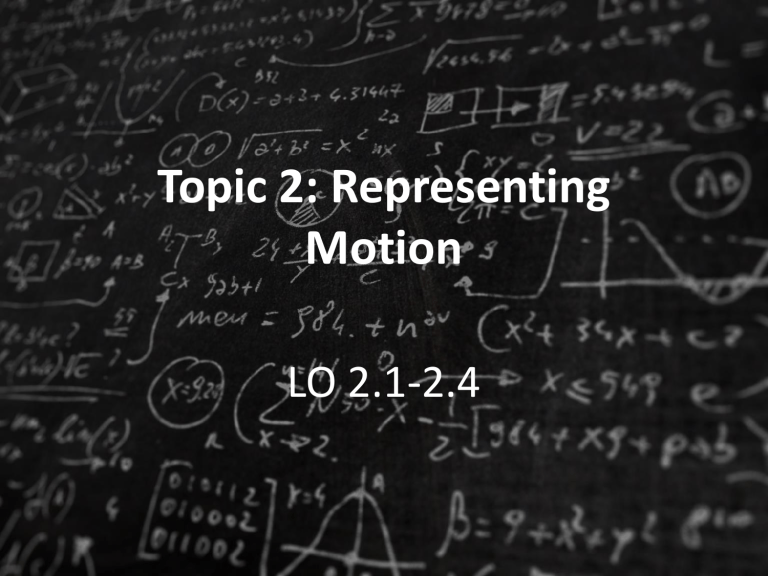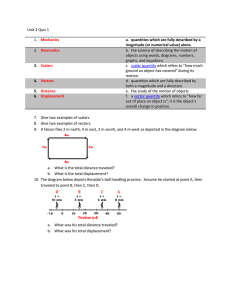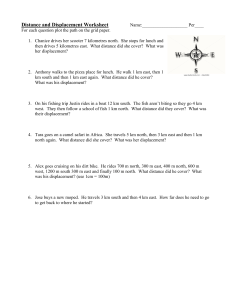
Topic 2: Representing Motion LO 2.1-2.4 Learning Objectives: Which of the following objects is moving? What is motion? • Motion is a change in position with respect to a fixed point. • To describe the motion of an object we need at least two factors: 1- position (place) of the object. 2- time. Particle model A model where the moving object is represented by a point. How far is Abu Dhabi? How far is Abu Dhabi • From Dubai? 126 km • From RAK? 166 km? • From Falaj Al Mualla? 216 km? • The answer depends on the starting point! Reference Frame/ Coordinate System The coordinate system with the origin as the reference point is called frame of reference. 1-dimensional coordinate system 2-Dimensional coordinate system Position • Position of an object is how far from the origin is the object with direction. • Position is a vector quantity (has a magnitude and direction) • It’s direction is expressed as +/• Its symbol is “x” • The SI unit of position is meter. Other units are cm, km, etc.. +- Position: ( / ) Convention + position is to the RIGHT - position is to the LEFT Xcat=+40 cm Xdog=-20 cm origin -50 cm -10 cm -30 cm -40 cm -20 cm 0 cm 50 cm 30 cm 10 cm 20 cm 40 cm +- Position: ( / ) Convention + position is UP - position is DOWN 50 cm 0 cm Xcat=+10 cm Xdog=-30 cm -50 cm origin Lesson Summary • Motion is a change in position with respect to a reference frame. • The coordinate system with the origin as the reference point is called frame of reference • Position of an object is how far from the origin is the object with direction. Scalars and Vectors • In physics, quantities could be classified into two groups: 1- Scalar quantities. 2- Vector quantities. • Scalar quantities are quantities that could be described by magnitude (value and unit) only. Examples: time, distance and speed • Vector quantities are quantities that could be described by magnitude (value and unit) and direction. Examples: position, displacement, velocity and acceleration Distance • When an object changes its position with respect to origin (moves), its motion is described by: 1- Distance 2- Displacement • Distance is the length of the entire path travelled by an object. • Distance is a scalar quantity, it is described only by magnitude. • The SI unit of distance is meter (m). • The distance travelled by an object depends on the path of the travel. Distance Example 1: An object travels from point A to point B. How much distance was travelled by the object A B m Answer: Distance = 3 m Example 2: B Answer: Distance = 5 m A m Distance Example 3: An object travels from point A to point B then to point C as shown in the below diagram. How much distance was travelled by the object A C B m Answer: Distance = 5 + 3 = 8 m Example 4: C Answer: Distance = 2 + 7 = 9 m A B m Distance Example 5: An object travels from point A to point B and comes back to point A as shown in the below diagram. How much distance was travelled by the object A Answer: Distance = 3 + 3 = 6 m B m Define Displacement • Displacement is the change in an object’s position with respect to the origin. It can be positive or negative. Initial position xi=0 cm Displacement: Dx = x f - xi Dx = 9cm- 0cm= +9cm Final position xf=9 cm Distance and displacement • Displacement is a vector quantity, it is described by magnitude and direction. • SI unit: meter (m). • Symbol: (∆x). • Mathematically, displacement is the shortest length between initial (starting) position and final (finishing) position with direction xi: the initial position displacement = ∆x = xf - xi xf: the final position • The displacement of an object does not depends on the path of the travel, it only depends on initial and final positions. Displacement Example 6: An object travels from point A to point B as shown in the below diagram. What is the object’s displacement? Represent it with an arrow. A Answer: xi = +1 m ∆x = xf - xi B m , xf = +4 m ∆x = (+4) – (+1) ∆x = +3 m Notice that the displacement is positive because the object travelled to the right between the initial and final positions Displacement Example 7: An object travels from point A to point B as shown in the below diagram. What is the object’s displacement? Represent it using an arrow. B Answer: xi = +1 m ∆x = xf - xi A m , xf = -4 m ∆x = (-4) – (+1) ∆x = -5 m Notice that the displacement is negative because the object travelled to the left between the initial and final positions Displacement Example 8: An object travels from point A to point B then to point C as shown in the below diagram. What is the object’s displacement? Represent it using an arrow. A B C m , xf = +4 m Answer: xi = -4 m ∆x = xf - xi ∆x = (+4) – (-4) ∆x = +8 m Notice that the displacement is positive because the object travelled to the right between the initial and final positions Displacement Example 9: An object travels from point A to point B then to point C as shown in the below diagram. What is the object’s displacement? Represent it using an arrow. C A B m Answer: xi = +2 m , xf = -3 m ∆x = xf - xi ∆x = (-3) – (+2) ∆x = -5 m Notice that the displacement is negative because the object travelled to the left between the initial and final positions Displacement Example 10: An object travels from point A to point B and comes back to A as shown in the below diagram. What is the object’s displacement? Represent it using an arrow. A Answer: xi = +1 m , xf = +1 m ∆x = xf - xi ∆x = (+1) – (+1) ∆x = 0 B m Compare and Contrast Distance and Displacement Distance • Total distance travelled • Scalar quantity and has magnitude only • Can only be + Displacement • Distance between starting and final position • Vector quantity has magnitude and direction • Can be +/- They are both length Both have SI unit: meter (m)






